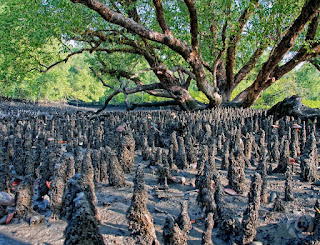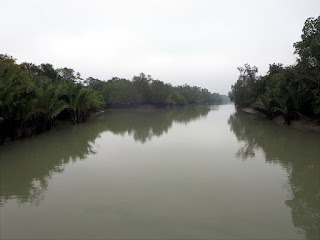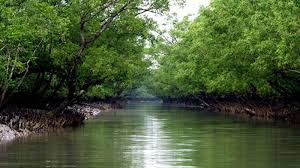Natural Beauty of Bangladesh ( About Sundarbans)
part: 2Source: Wikipedia
This article is about the Bangladeshi part.
Sundarbans
 |
| Sundarbans |
This section doesn't cite any sources. Please facilitate improve this section by adding citations to reliable sources. Unsourced material could also be challenged and removed. (November 2018)
The Sundarban forest lies within the huge delta on the Bay of geographical region shaped by the super confluence of the Ganges River, Hooghly, Padma, Brahmaputra River and Meghna rivers across southern East Pakistan. The seasonally flooded Sundarbans fresh swamp forests lie midland from the angiospermous tree forests on the coastal fringe. The forest covers ten,000 km2 (3,900 sq mi) of that concerning half dozen,000 km2 (2,300 sq mi) are in East Pakistan. It became inscribed as a UN agency world heritage web site in 1997. The Indian a part of Sundarbans is calculable to be concerning four,110 km2 (1,590 sq mi), of that concerning one,700 km2 (660 sq mi) is occupied by waterbodies within the kinds of stream, canals and creeks of dimension variable from some metres to many kilometres.
The Sundarbans is intersected by a fancy network of recurrent event waterways, mudflats and little islands of salt-tolerant angiospermous tree forests. The interconnected network of waterways makes virtually each corner of the forest accessible by boat. the realm is thought for the Bengal tiger} (Panthera tigris tigris), further as varied fauna as well as species of birds, noticed cervid, crocodiles and snakes. The fertile soils of the delta are subject to intensive human use for hundreds of years, and therefore the ecoregion has been principally reborn to intensive agriculture, with few enclaves of forest remaining. The remaining forests, taken along with the Sundarbans mangroves, are necessary surround for the vulnerable tiger. to boot, the Sundarbans serves a vital operate as a protecting barrier for the numerous inhabitants in and around Khulna and Mongla against the floods that result from the cyclones. The Sundarbans has additionally been noncommissioned among the finalists within the New7Wonders of Nature.
Physiography
The angiospermous tree-dominated Ganges River Delta – the Sundarbans – could be a advanced scheme comprising one in every of the 3 largest single tracts of mangrove forests of the globe. Larger half is located in East Pakistan, a smaller portion of it lies in Asian country. The Indian a part of the forest is calculable to be concerning forty %, whereas the Bangladeshi half is sixty %. To the south the forest meets the Bay of Bengal; to the east it's finite by the Baleswar stream and to the north there's a pointy interface with intensively ploughland. The natural evacuation within the upstream areas, apart from the most stream channels, is all over obstructed by in depth embankments and polders. The Sundarbans was originally measured (about two hundred years ago) to be of concerning sixteen,700 sq. kilometres (6,400 sq mi). currently it's dwindled into concerning 1/3 of the initial size. the overall acreage nowadays is four,143 sq. kilometres (1,600 sq mi), as well as exposed sandbars with a complete space of forty two sq. kilometres (16 sq mi); the remaining water space of one,874 sq. kilometres (724 sq mi) encompasses rivers, tiny streams and canals. Rivers within the Sundarbans are meeting places of salt water and fresh. Thus, it's a part of transition between the fresh of the rivers originating from the Ganges River and therefore the saline water of the Bay of geographical region.
The Sundarbans on the Bay of geographical region has evolved over the millennia through natural deposition of upstream sediments in the course of coast segregation. The geographics is dominated by deltaic formations that embrace incalculable evacuation lines related to surface and aquatic levees, splays and recurrent event flats. There are marginal marshes on top of mean tide level, recurrent event sandbars and islands with their networks of recurrent event channels, aquatic distal bars and proto-delta clays and silt sediments. The Sundarbans' floor varies from zero.9 to 2.11 metres (3.0 to 6.9 ft) on top of water level.
Biotic factors here play a major role in physical coastal evolution, and for life a spread of habitats have developed that embrace beaches, estuaries, permanent and semi-permanent swamps, recurrent event flats, recurrent event creeks, coastal dunes, back dunes and levees. The angiospermous tree vegetation itself assists within the formation of recent dry land and therefore the coast vegetation plays a major role in swamp morphology. The activities of angiospermous tree fauna within the coast mudflats develop micromorphological options that entice and hold sediments to form a stratum for angiospermous tree seeds. The morphology associated evolution of the Aeolian dunes is controlled by an abundance of xeric and halophytic plants. Creepers, grasses and sedges stabilise sand dunes and uncompacted sediments. The Sunderbans mudflats (Banerjee, 1998) are found at the body of water and on the deltaic islands wherever low speed of stream and stream happens. The flats are exposed in low tides and submerged in high tides, therefore being modified morphologically even in one recurrent event cycle. The tides are thus giant that about one third of the land disappears and reappears each day. the inside elements of the mudflats function an ideal home for mangroves.
See also: List of rivers of Sundarbans
Ecoregions
Sundarbans options 2 ecoregions — "Sundarbans fresh swamp forests" (IM0162) and "Sundarbans mangroves" (IM1406).
Sundarbans fresh swamp forests
The Sundarbans fresh swamp forests are a tropical damp broad-leaved forest ecoregion of East Pakistan. It represents the briny swamp forests that lie behind the Sundarbans Mangroves, wherever the salinity is a lot of pronounced. The fresh ecoregion is a region wherever the water is simply slightly briny and becomes quite contemporary throughout the time of year, once the fresh plumes from the Ganges River and therefore the Brahmaputra River rivers push the intrusive salt water out and convey a deposit of silt. It covers fourteen,600 sq. kilometres (5,600 sq mi) of the huge Ganges-Brahmaputra Delta, extending from the northern a part of Khulna District and finishing at the mouth of the Bay of geographical region with scattered parts extending into India's West Bengal state. The Sundarbans fresh swamp forests lie between the upland Lower Gangetic plains damp deciduous forests and therefore the brackish-water Sundarbans mangroves bordering the Bay of geographical region.
 |
| Sundarbans |
A victim of large-scale clearing and settlement to support one in every of the densest human populations in Asia, this ecoregion is underneath a good threat of extinction. many years of surroundion and exploitation have exacted a significant toll on this ecoregion's habitat and variety. There are 2 protected areas – Narendrapur (110 km2) and Ata Danga Baor (20 km2) that cowl a mere one hundred thirty km2 of the ecoregion. surround loss during this ecoregion is thus in depth, and therefore the remaining surround is thus fragmented, that it's tough to establish the composition of the initial vegetation of this ecoregion. per Champion and Seth (1968), the fresh swamp forests are defined by Heritiera minor, Xylocarpus molluccensis, Bruguiera conjugata, Sonneratia apetala, tree, and Sonneratia caseolaris, with lauhala, purau, and palm on the fringing banks.
Sundarbans Mangroves
See also: angiospermous tree
The Sundarbans Mangroves ecoregion on the coast forms the seaward fringe of the delta and is that the world's largest angiospermous tree scheme, with 20,400 sq. kilometres (7,900 sq mi) of a region lined. The dominant angiospermous tree species Heritiera Fomes is regionally referred to as sundri or sundari. angiospermous tree forests aren't home to a good type of plants. they need a thick cover, and therefore the coppice is usually seedlings of the angiospermous tree trees. Besides the sundari, alternative tree species within the forest embrace asterid dicot genus, Xylocarpus mekongensis, Xylocarpus granatum, Sonneratia apetala, Bruguiera gymnorhiza, Ceriops decandra, asterid dicot genus corniculatum, Rhizophora mucronata, and liliopsid genus fruticans palms. Twenty-six of the fifty broad angiospermous tree species found within the world grow well within the Sundarbans. The unremarkably classifiable vegetation varieties within the dense Sundarbans angiospermous tree forests are salt water mixed forest, angiospermous tree scrub, briny water mixed forest, littoral forest, wet forest and wet sediment grass forests. The East Pakistan angiospermous tree vegetation of the Sundarbans differs greatly from alternative non-deltaic coastal angiospermous tree forests and upland forests associations. in contrast to the previous, the family Rhizophoraceae are of minor importance.
Ecological succession
Ecological succession is mostly outlined because the serial occupation of a web site by completely different plant communities. In associate accreting mudflats the outer community on the sequence represents the pioneer community that is bit by bit replaced by the subsequent community representing the seral stages and at last by a climax community typical of the zone. Robert Scott Troup urged that succession began within the freshly accreted land created by contemporary deposits of scoured soil. The pioneer vegetation on these freshly accreted sites is Sonneratia, followed by asterid dicot genus and liliopsid genus. because the ground is elevated as a results of soil deposition, alternative trees build their look. the foremost rife, tho' one in every of the late species to look, is Excoecaria. because the level of land rises through accretion and therefore the land is simply often flooded by tides, Heritiera Fomes begins to look.
Flora
A total 245 genera and 334 plant species were recorded by David Prain in 1903. whereas most of the mangroves in alternative elements of the globe are defined by members of the family Rhizophoraceae, Avicenneaceae or dicot family, the mangroves of East Pakistan are dominated by the family Malvaceae and spurge family.
 |
| Sundarbans |
The Sundarbans flora is defined by the abundance of sundari (Heritiera fomes), gewa (Excoecaria agallocha), goran (Ceriops decandra) and keora (Sonneratia apetala) all of that occur conspicuously throughout the realm. The characteristic tree of the forest is that the sundari (Heritiera littoralis), from that the name of the forest had most likely been derived. It yields a tough wood, used for building homes and creating boats, piece of furniture and alternative things. New forest accretions is commonly prominently dominated by keora (Sonneratia apetala) and recurrent event forests. it's associate indicator species for freshly accreted mudbanks and is a very important species for life, particularly noticed cervid (Axis axis). there's abundance of dhundul or passur (Xylocarpus granatum) and kankra (Bruguiera gymnorhiza) tho' distribution is discontinuous. Among palms, Poresia coaractata, Myriostachya wightiana and golpata (Nypa fruticans), and among grasses spear grass (Imperata cylindrica) and khagra (Phragmites karka) are well distributed.
The kinds of the forests that exist in Sundarbans embrace angiospermous tree scrub, littoral forest, water mixed forest, briny water mixed forest and swamp forest. Besides the forest, there are in depth areas of briny water and fresh marshes, coast mudflats, sandflats, sand sand dunes with typical dune vegetation, open biome on sandy soils and raised areas supporting a spread of terrestrial shrubs and trees. Since Prain's report there are substantial changes within the standing of varied angiospermous tree species and assortment revision of the man-grove flora. However, little or no exploration of the botanic nature of the Sundarbans has been created to stay up with these changes. variations in vegetation are explained in terms of fresh and low salinity influences within the Northeast and variations in evacuation and siltation. The Sundarbans has been classified as a damp tropical forest demonstrating a full mosaic of seres, comprising primary settlement on new accretions to a lot of mature beach forests. traditionally vegetation varieties are recognised in broad correlation with variable degrees of water salinity, fresh flushing and geographics.
Fauna











No comments:
Post a Comment